How Long Do Birds Take To Find A New Feeder? [ANSWERED!]
We’re reader-supported; we may earn a commission from links in this article.
Birds may take a long time to find a new feeder. You might then be wondering: “How long do birds take to find bird feeders?!” I too was curious so I did my research on bird feeding data and found a definitive answer. Here’s what I found:
Birds take about 10 days to find a new feeder. Birds typically take 5 – 18 days to find feeders, depending on the feeder location, the local bird species, the safety of the environment, and the time of day. For example, birds in Utah take 18.8 days but birds in Arizona take 6.2 days to find new bird feeders.
Getting nervous about birds not visiting? Not to worry! If you carry on reading, I’ll cover some caveats, explain how birds are attracted, list reasons why they aren’t going to yours, and offer some counteractive steps you can take.
Read on to find out more:
How Long Birds Take To Find Feeders (I Conducted A MASSIVE Analysis Experiment!)
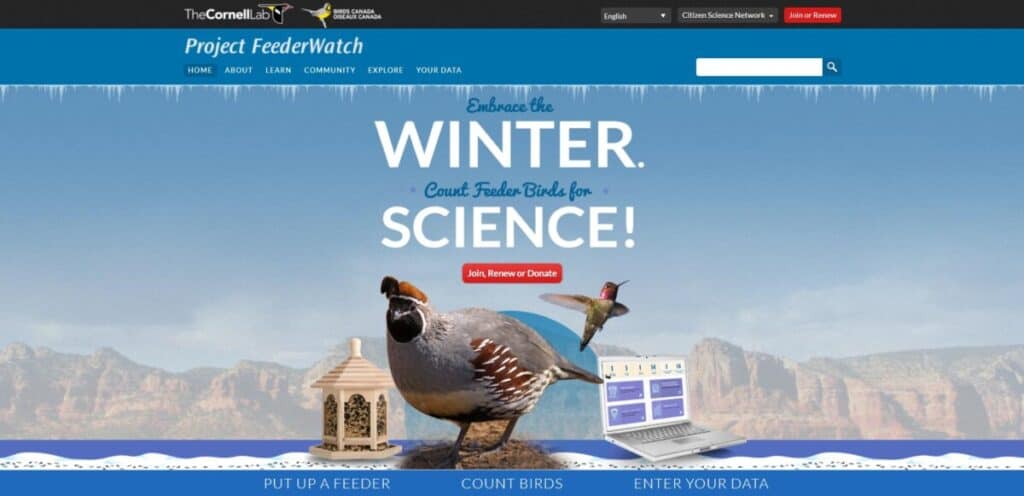
I’ve seen many forums of people asking about this question and they would often get very vague answers based on what they feel it’s like. Being a guy who’s crazy about birds and data, I decided to analyze some data on my own.
And so, I looked at the data collected from the awesome participants of Project FeederWatch, which is a program organized and managed by Birds Canada and the Cornell Lab of Ornithology. Thanks, participants!
To get the bird feeder finding duration, I measured the difference in time from a feeding site was first created, to the very first time a bird was observed at the site.
With that, I was able to find the average time it takes for a bird to find a bird feeder! Voila, data is like magic; now we know things that we previously didn’t know.
It takes about 10 days, ranging from 5 to 18 days, for birds to find a bird feeder for the first time. The duration birds take to find feeders can vary due to several factors such as feeder location, the local bird species, the safety of the environment, and the time of day.
Now, what does that all mean? Read on and let me break it down for you:
We can clearly see that most birds are observed at feeders within just one day, but we must also take into context that this doesn’t happen all the time – it only takes up about 7% of all observations! When I considered the other observations, the likely range of seeing your bird at feeders for the first time would be within 5 to 18 days!
Now let’s look at the different finding durations in a different interactive graph that I made:
Learning Tableau as a beginner isn’t easy, but I’m glad I got to see the value of it now!
In the above graph, you can either start by clicking the dropdown to look at the average bird finding duration for a particular species! In doing so, you will begin to find out which bird species are the ones that will most likely be the ones you see first.
Here’s how you can do it: Click on one of the top 30 most common birds seen at backyards on the right. This will filter the graphs for that species only!
Now you can see which state you can see that bird and the average and median bird feeder finding durations below. Voila, you’ve got your answer!
The different shades of turquoise blue represent the average duration it takes for feeding sites to find birds for each state. Basically, the darker the blue, the longer it takes for a bird to arrive!
If you’re wondering at what time of the day do birds feed, check out an article I wrote on it here!
How Long Will It Take for Birds To Find Feeders In My State?
Also, knowing just the general bird feeder finding duration makes no sense if it just isn’t specific enough to your state, right? No worries, I got you covered too.
You can either select your state/province or simply click on the shape of your state you want to explore! Here’s how to do it:
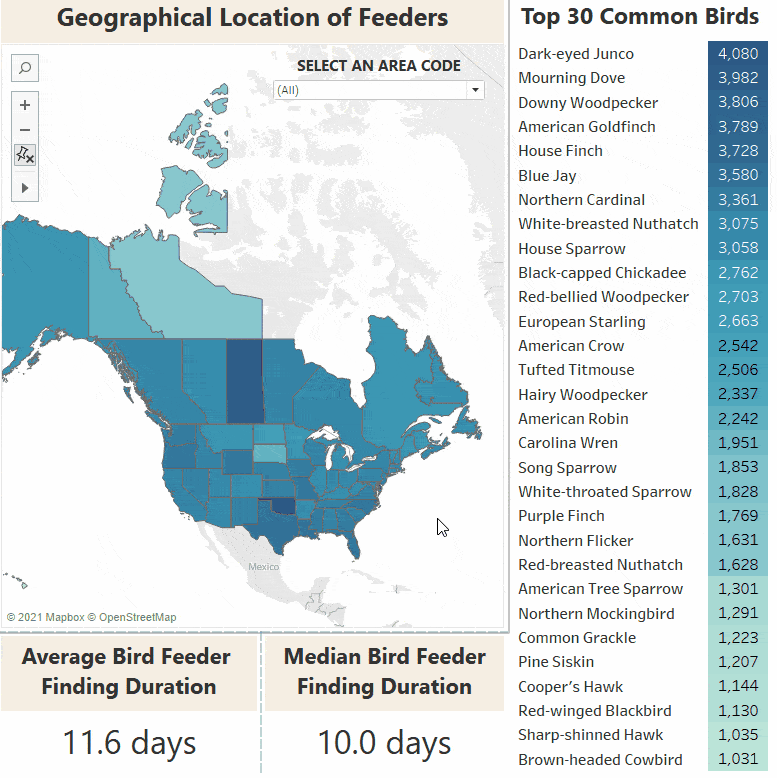
Well, if you find it more convenient to look through a table for the average feeder finding duration for each state, here it is:
| Country | State/Province | Average Bird Feeder Finding Duration (days) |
| US | Arizona | 6.2 |
| US | Arkansas | 10.8 |
| US | California | 14 |
| US | Colorado | 9.7 |
| US | Connecticut | 13.1 |
| US | Delaware | 14 |
| US | Florida | 12.6 |
| US | Georgia | 13.7 |
| US | Idaho | 9.9 |
| US | Indiana | 11.5 |
| US | Kansas | 10.6 |
| US | Kentucky | 13.1 |
| US | Louisiana | 8.2 |
| US | Maine | 9.4 |
| US | Maryland | 14.1 |
| US | Massachusetts | 11.9 |
| US | Michigan | 10.4 |
| US | Minnesota | 10.7 |
| US | Mississippi | 16.5 |
| US | Missouri | 14.8 |
| US | Montana | 11 |
| US | New Hampshire | 11.2 |
| US | New Jersey | 12.5 |
| US | New Mexico | 16.2 |
| US | New York | 12.5 |
| US | North Carolina | 15.2 |
| US | North Dakota | 10.3 |
| US | Ohio | 11.3 |
| US | Oklahoma | 16.8 |
| US | Oregon | 12.4 |
| US | Rhode Island | 8.4 |
| US | South Carolina | 15.4 |
| US | South Dakota | 9.2 |
| US | Tennessee | 14.1 |
| US | Texas | 14.4 |
| US | Utah | 18.8 |
| US | Vermont | 11.3 |
| US | Virginia | 13.4 |
| US | Washington | 12.1 |
| US | West Virginia | 13.1 |
| Canada | Alberta | 11.2 |
| Canada | British Columbia | 11.6 |
| Canada | Manitoba | 11.7 |
| Canada | New Brunswick | 10.6 |
| Canada | Newfoundland and Labrador | 11.1 |
| Canada | Northwest Territories | 8 |
| Canada | Nova Scotia | 11.3 |
| Canada | Ontario | 11.5 |
| Canada | Prince Edward Island | 9.5 |
| Canada | Quebec | 10.7 |
| Canada | Saskatchewan | 13.7 |
| Canada | Yukon | 9.3 |
Now that you’ve looked at the average duration it will take for birds to arrive and which bird would most likely arrive at your bird feeder first, hopefully, you would already feel much better about that decision you made to purchase/set up a new feeder in your yard!
Don’t worry about it too much! If there’s a buffet out there, the birds will eventually come; you just need patience. There’s no recorded site with NO birds coming to their feeders, so rest assured, you’ll be fine!
Besides the duration birds take to find feeders, there are other reasons why birds may not come to your feeder. Check out this article where I list out 29 reasons in great detail!
Which Birds Are Likely To Find My Feeder First?
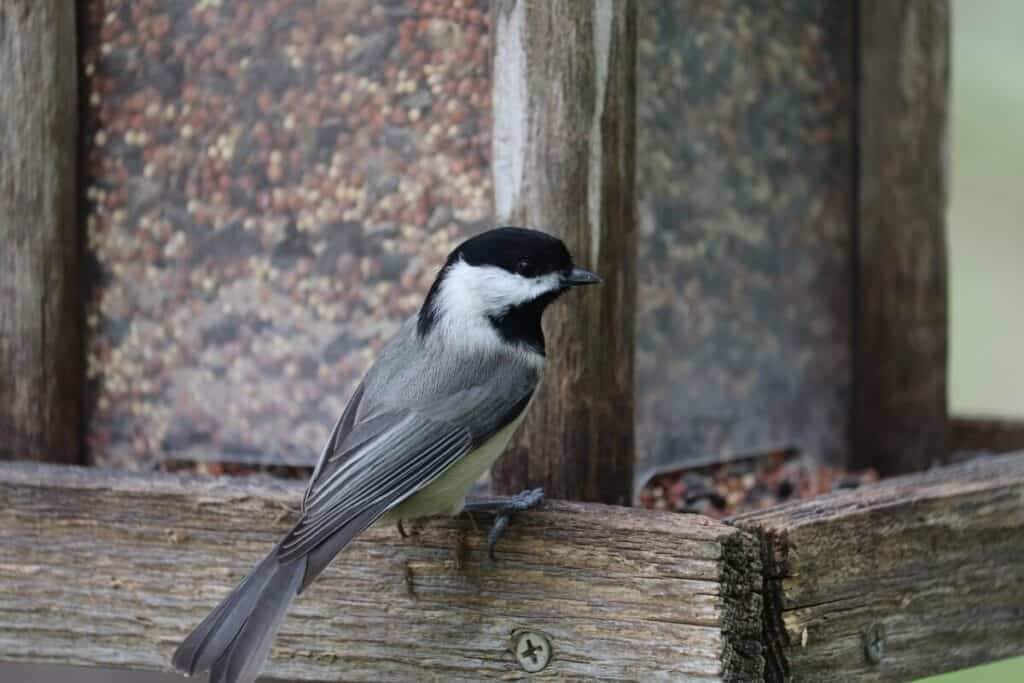
The top 10 birds that are likely to find feeders first are Black-capped Chickadees, followed by Northern Cardinals, Dark-eyed Juncos, House Sparrows, White-breasted Nuthatches, Blue Jays, House Finches, Mourning Doves, American Goldfinches, and Downy Woodpeckers. They are all expected to arrive within 8 to 10 days.
Here’s an interactive graph so you can take a look at how the data looks like!
All of these birds were observed during Project FeederWatch and have at least 1000 observations and sorted for the fastest average feeder finding durations. Cooooool stuff!
How Do Birds Find Feeders?
Now that we know how long it takes for birds to find a feeder, I’ll let you in on the secrets of attracting birds to your feeders, and the science of how birds find feeders. (According to experience, and of course the advice of many on forums!)
1. Birds Rely on Their Sight
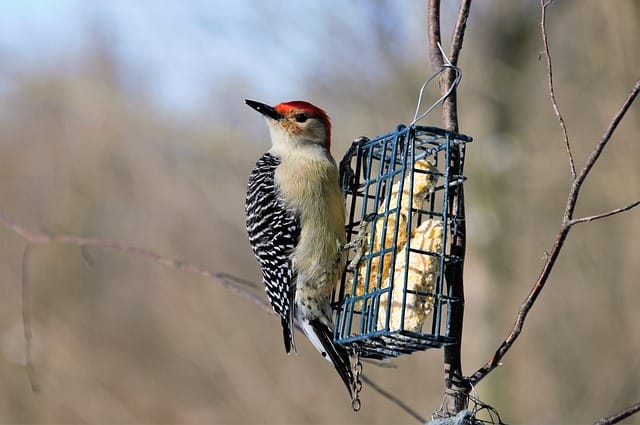
Birds have a bad sense of smell, but they have AMAZING eyesight! Maybe that’s why they coined the phrase “birds’ eye view”! Birds that are out foraging for food will be looking out for other birds that seem to be devouring the feed at feeders around them.
According to a fellow member of a birdwatching Facebook group, “attract one, and they’ll all bring their friends along!”
That being said, the more feeders that you have set up, the more likely birds will be able to find your feeder and recognise that as a source of food!
Also, it’s highly likely that you’ll have birds feeding at your feeder faster if your neighbors already have lots of feeders, so birds are used to feeding at them.
With such amazing eyesight, birds are actually attracted to some colors more than others! In a study by some wonderful bird scientists, they discovered that feeders that had more camouflaged colors such as green, silver, or black saw a greater number of birds feeding on them!
In contrast to red and yellow, which had the least number of birds feeding on them. So keep that in mind, and I’ll share more on how you can work on that later on in this article!
2. Birds Rely on Their Sense of Hearing
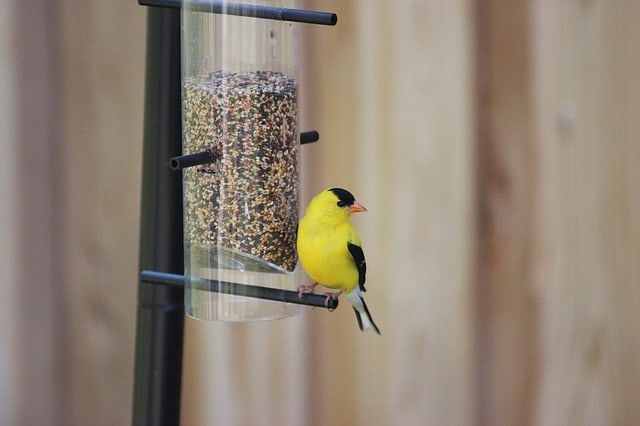
Birds have a great sense of hearing, as demonstrated by their beautiful songs and chirps that we hear throughout the day!
Ever started salivating when the ice cream truck sounded off along the sidewalk? Or felt super excited your toast when you hear it pop?
Well, birds are also kind like us! They find their sources of food and water from their sense of hearing.
MANY backyard birders have given me advice on Facebook groups to not just hang out bird feeders, but also to have a birdbath nearby, and better yet, one with moving water.
With the sounds of moving water, birds will be more attracted to your feeding site, with both food and water available. That’s a full-course buffet and bath for the birds!
10 Reasons Why Birds Are Not Coming To Your Feeders
Okay, so you know how long it would take for birds to come, and you know how they would find your bird feeder. Now you need to know some small but impactful reasons why the birds just aren’t coming! Here’s 10 of them:
1. Birds Are Feeding on Natural Food Sources
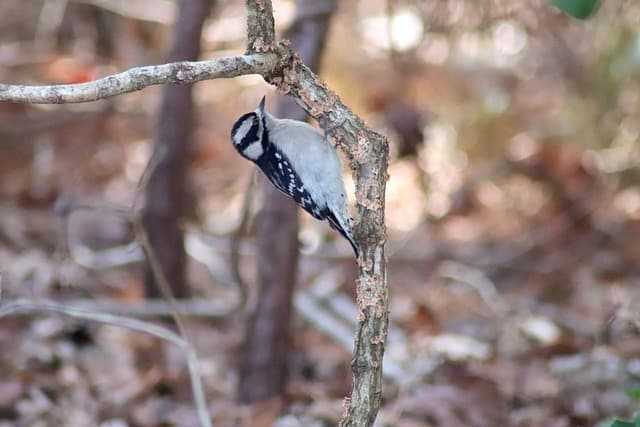
If you’re in a neighborhood where the idea of a bird feeder is new to birds, then it’s highly likely that birds are still relying on natural food sources to fill their stomachs!
Give it some time, and wait and see if birds eventually will learn that they can find food regularly at your feeders.
2. Birds Are Scared Of Predators Nearby
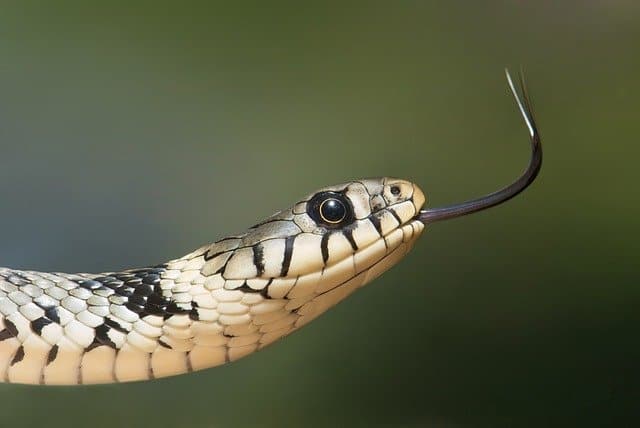
Birds are generally very skittish creatures and are very wary of predators, even while they feed. You need to look around and think of any ways that snakes, cats, or other predators may threaten to kill them.
I remember I was looking through a Facebook group one day and saw someone who posted a picture of a very lowly mounted birdhouse with a snake on it.
I guess you can deduce what happened: the bird eggs were devoured. In the same way, ensure that the elevation for your birdbath, birdhouse, and bird feeders are sufficient and out of reach of predators.
Also, ensure that the feeder cannot be reached easily by snakes from trees nearby. This may scare birds off!
3. Birds Are Scared of Other Threats Nearby
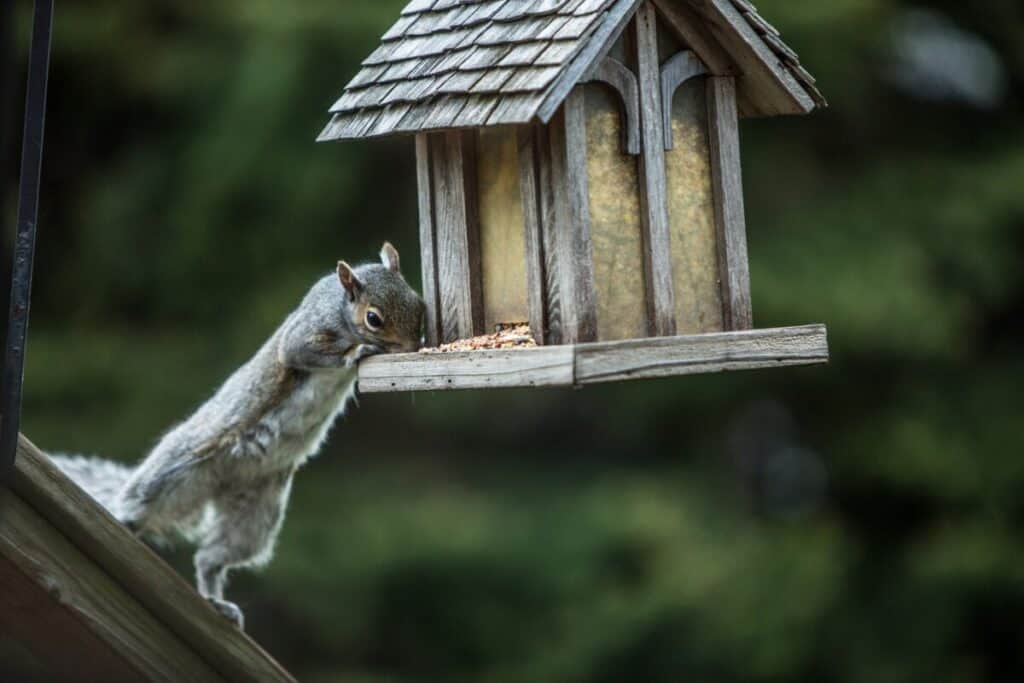
Other than predators, there are other things that birds are afraid of. Everyone knows that when there is a loud noise, birds will always be seen flying off to safety first!
So if you can set up your feeder in a quiet environment, birds will be more likely to settle to feed.
Squirrels are animals that are considered somewhat of a threat, although not a predator to the birds. Squirrels can easily hop to or climb up feeding poles to compete with the birds for the feed.
Solutions to this would be to either set up another lower feeder for the squirrels or set up a metal baffle at the bottom of the feeder so they can’t get past it.
It’s up to you how you want to deal with them, as different birders have different preferences with regards to squirrels!
4. Using Only One Type of Feeder
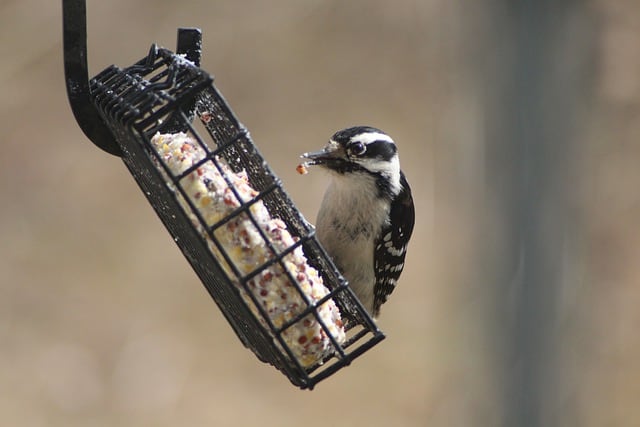
A big mistake that most beginner backyard birders are that they would only set up just ONE type of feeder! There are so many different kinds of feeders, and each of them has its own purpose to store a particular feed to attract a particular bird species.
Having a buffet of different types of feeders will allow you to diversify the bird species that will be attracted to your feeding station.
Advice given to me from most Facebook groups in the past would be to set up one of each kind of bird feeder.
If you’re unclear on the types of bird feeders, they are the hopper feeders, tube feeders, nyjer Feeders, suet feeders, platform feeders log feeders, and hummingbird feeders; just to name a few!
My advice: just buy multiple types of feeders! The more the merrier. Having multiple feeders is kind of like tattoos or pringles; you can’t stop at one!
5. Your Bird Feeder Wasn’t Put Out Early Enough
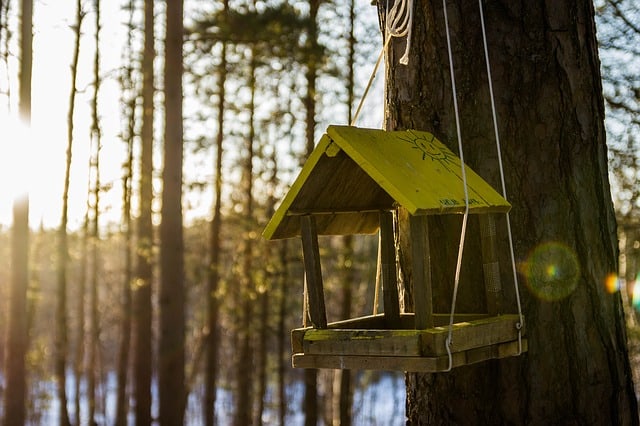
If you’ve looked closely at the data I analyzed above, then you’ll know that it takes time for birds to find feeders.
So, you gotta start putting out your bird feeders earlier in advance before the period you actually want to see birds at your feeder.
My advice: set up your feeder at least 2 weeks in advance of the period you want to see birds feeding.
6. Dirty Bird Feeders
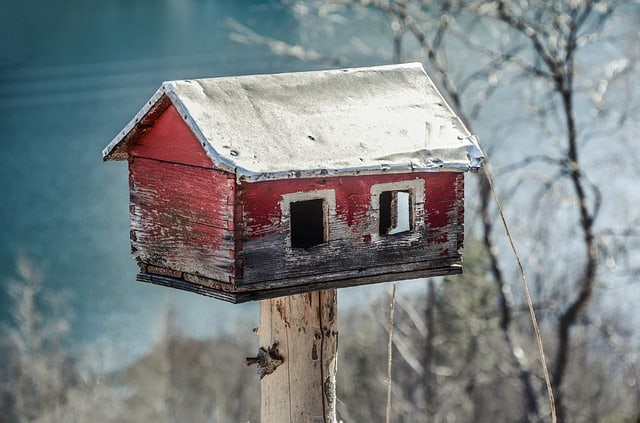
Can you imagine eating from a dirty plate, that’s kind of how it would be like to feed on a dirty feeder! Birds intentionally avoid an unclean eating environment, so you need to clean it regularly.
By cleaning, I mean to check if there are any moldy or wet feed that is starting to look bad or smell bad. This also goes a long way to ensure that you are responsible for the health of the birds you feed!
7. Your Bird Feeder Color Isn’t Ideal For Birds
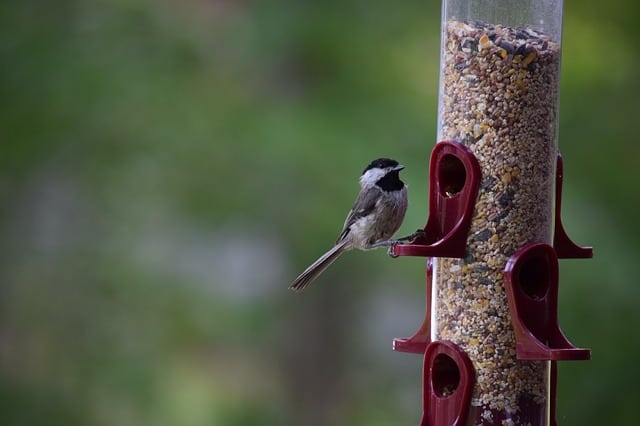
Remembered how I mentioned earlier on about some colors attracting more birds than others? I didn’t forget to tell you how to settle that, didn’t I?
Okay, so you know that scientists have evidence that camouflaged colors such as green, silver, and black are more attractive to the birds. This is because birds want to feel safe when they are feeding!
Now, what happens if you already have a bright-colored feeder like red or yellow? No worries! Feeders that are red or yellow are still attractive to birds that have the same-colored plumage.
For example, a yellow feeder will still be fine for an American Goldfinch.
This is because, in the study, UK birds such as blue tits, great tits, and house sparrows were the most common birds seen feeding on the feeders. These are skittish birds that require more camouflage when eating.
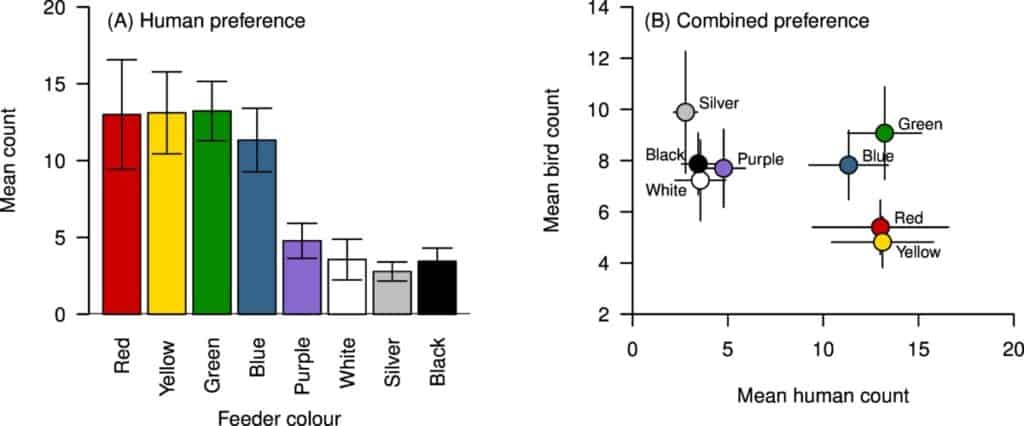
If you’re looking to buy new feeders, get some in camouflage colors: green, black, grey. If you already have feeders that are brightly colored and don’t want to purchase new ones; consider painting them.
Make sure to use safe paint like outdoor acrylic paint if you do.
8. The Birds Have Already Migrated
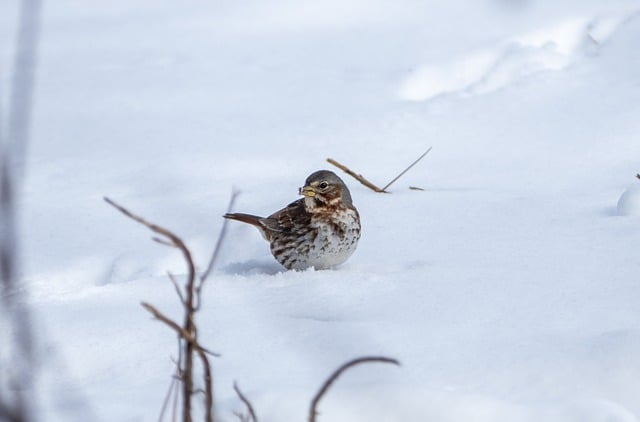
There is a possibility that the time of the year that you set up your bird feeder also coincides with the bird migration periods.
If you stay further up in the North, the birds would have begun their migration during Autumn, and will only come back in Spring.
So if you’ve set up your feeder during the months from Autumn to Spring, you’re less likely to have birds visit your feeder. No worries – just wait until Spring, when birds breed and feed like crazy!
9. You Didn’t Install Birdhouses or Birdbaths
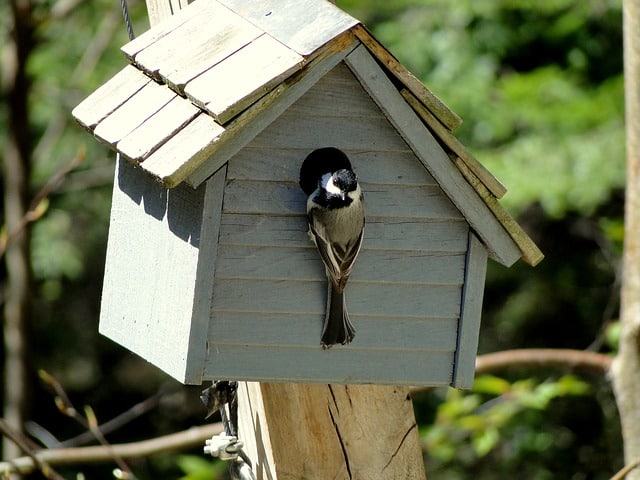
While doing my research, this was one of the biggest and most recommended resolutions of all: to set up birdhouses or birdbaths.
I left it to the last few because it requires more money and time commitment, and I know not many of you want to spend a truckload for this to work.
Installing birdhouses during winter to prepare for the upcoming spring season is perfect to get yourself set up for birds to come to your feeders.
It’s like a complete Bed and Breakfast!
They get to house their kids and feed them well. Picture this: the baby birds that grow up in birdhouses will eventually need to find food sources such as your feeder to support themselves.
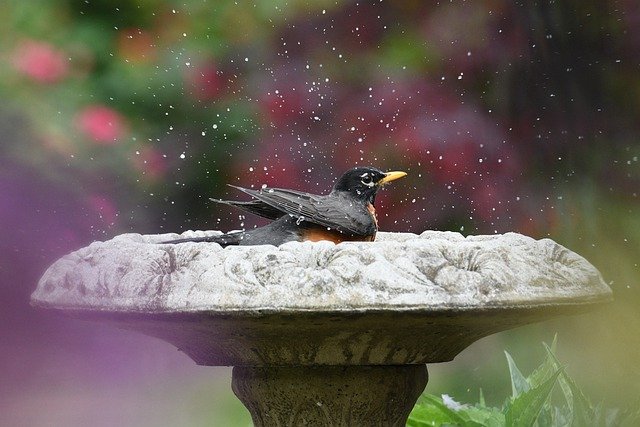
Installing birdbaths with moving water does great to attract birds really quickly. Of course, this would take time to set up, but it’s really worth it. Moving water is often an indication of a thriving ecosystem nearby. With moving water, birds will be able to both see and hear its presence from a distance away. With birds frequenting your birdbath for both drinking and bathing, it’s a no-brainer to also begin feeding off the buffet bird feeder you’ve got in your yard!
10. You Need To Be Patient
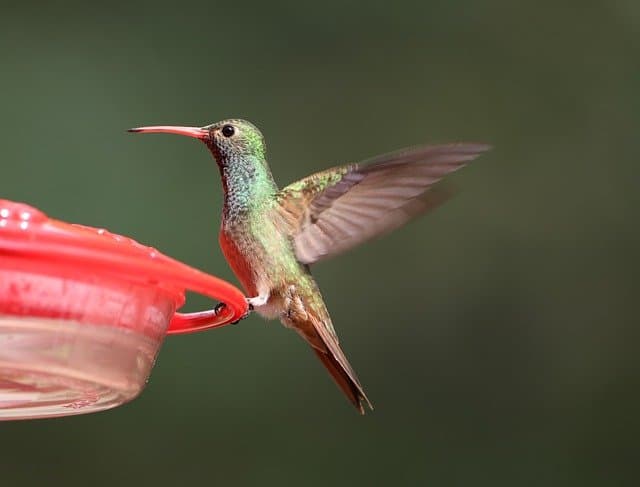
Last but not the least, the most important point. After learning so much about the average duration it takes for other birders take for birds to come to their feeders, I hope it sets your heart at more ease.
Take it easy! Backyard birdwatching is a pastime that is supposed to be relaxing and calm. Be patient and set up the buffet table, the bath, and the accommodation. If you build it, they will come!
Final Thoughts
In this article, you’ve learned how long birds take to find feeders for the first time, how birds find feeders, and some reasons why birds just aren’t coming to your feeders.
Hopefully, with all the insight and knowledge I’ve compiled for you, you will be able to see some feathered friends at your feeders soon. Really, I mean it! Many have done it, so can you.
Have patience and happy birding!
References
- Rothery L, Scott GW, Morrell LJ (2017) Colour preferences of UK garden birds at supplementary seed feeders. PLoS ONE 12(2): e0172422. https://doi.org/10.1371/journal.pone.0172422
My Recommended Birding Resources:
Hey there, Justin here!
Here’s a list of all my favorite resources, products, and brands I trust and love.
My Celestron Nature DX 8×42 Binoculars: It’s a great budget pair for beginner birders. Highly valued for its price! Read my review.
Safe Paint for Bird Baths Guide: Learn about non-toxic paint for painting bird baths.
Safe Sealers for Bird Baths Guide: Learn which sealers are safe for bird baths.
Safe Paint for Bird Feeders Guide: Learn what special care needs to be taken to paint bird feeders with the right paint.
Safe Paint for Birdhouses Guide: Learn about non-toxic paint for painting birdhouses. (Not the same as bird baths!)
Bird Identification Apps Guide: 2 of my favorite birding apps are Merlin Bird ID, and eBird Mobile! Merlin is great for tracking and identifying birds, and eBird Mobile is great for tracking the birds sighted when birding.
Check out my resources page for the full list of resources I recommend!

Justin Chia
Justin is the founder and author of Birding Outdoors. He is a Nanyang Technological University (NTU) alumnus with a Bachelor of Biological Sciences and a former data analyst.
Now, Justin runs the Birding Outdoors blog full-time, hoping to share his deep love for birds, birding, and nature with others.
To unwind, Justin enjoys gaming and reading.

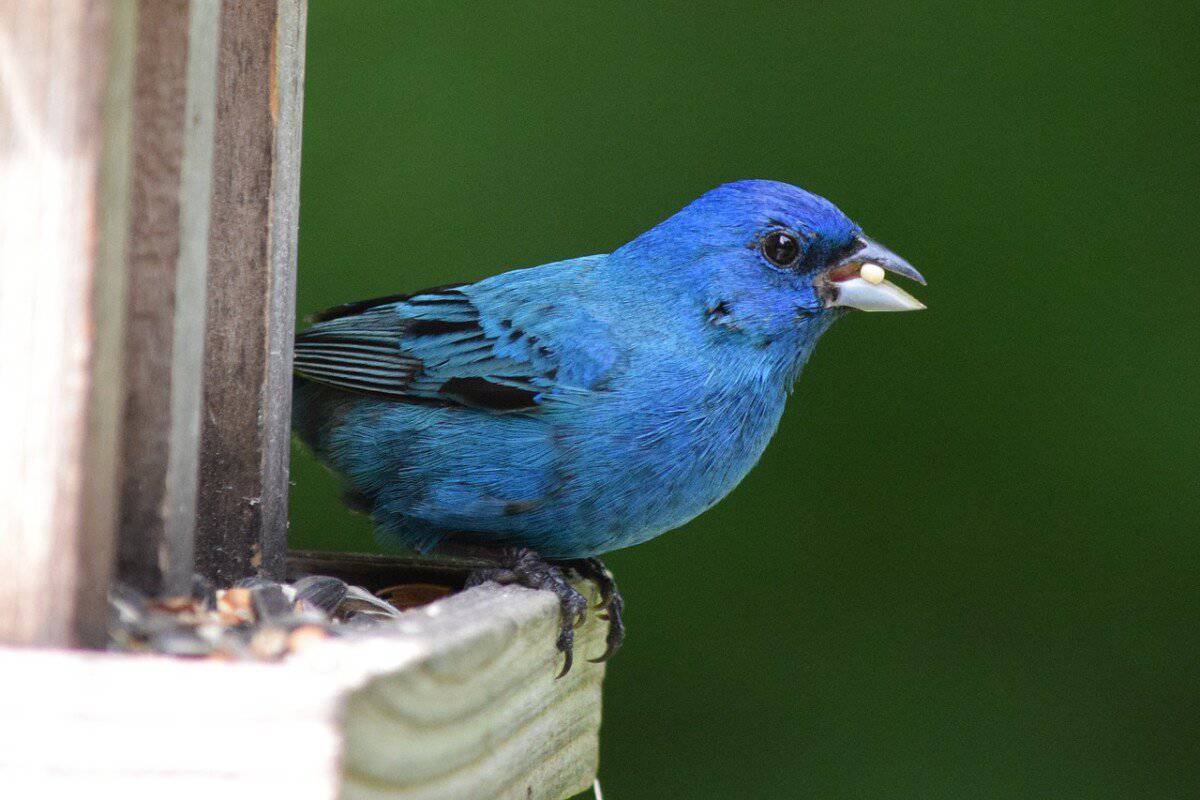

![How Many Bird Feeders Should You Have? [ANSWERED! + FAQs]](https://birdingoutdoors.com/wp-content/uploads/2021/06/feeders-2-768x512.jpg)
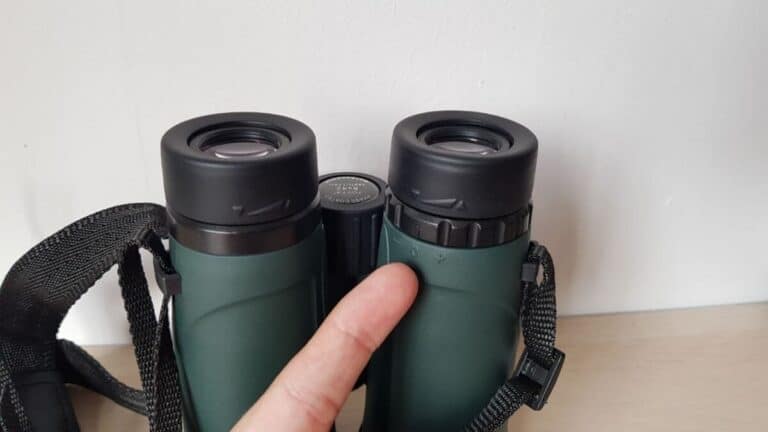
![How Often You Should Change Bird Bath Water [ANSWERED!]](https://birdingoutdoors.com/wp-content/uploads/2021/10/bird-bathing-768x512.jpg)
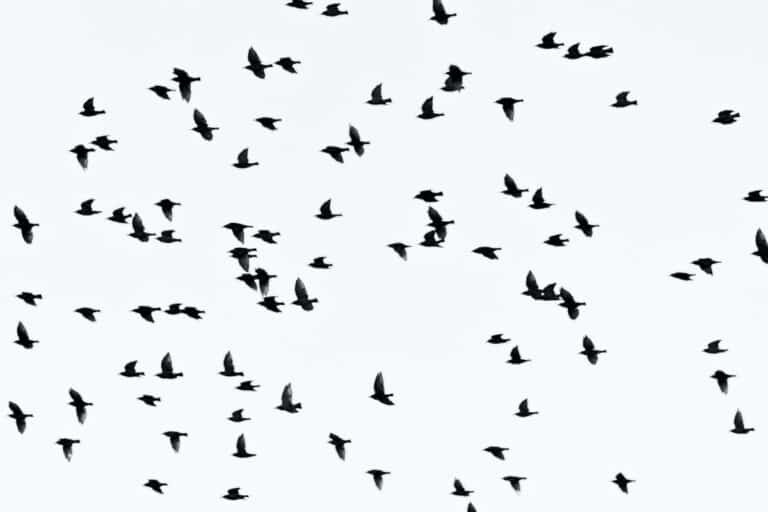
![How Long Do Birds Take To Learn To Fly? [ANSWERED!]](https://birdingoutdoors.com/wp-content/uploads/2021/05/main-pic-fledgling-768x512.png)